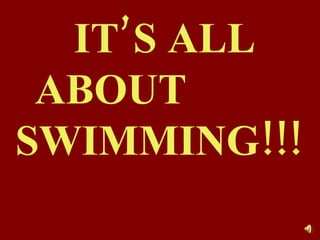
Presentation S A M A P E H!!!!!!!!!!!!!!!
- 1. IT’S ALL ABOUT SWIMMING!!!
- 2. BY: CHRISTIANE J. COCHING FOR THE TEAM BRAVO
- 3. WHAT IS SWIMMING? THE AQUATIC SPORT OF SWIMMING IS BASED ON THE HUMAN ACT OF SWIMMING,THAT IS, LOCOMOTION IN WATER BY SELF PROPULSION, WITH THE GOAL OF COMPLETING A GIVEN DISTANCE IN THE SHORTEST AMOUNT OF TIME. IN SOME COMPETITIONS SWIMMING IS FOR THE ENHANCEMENT OF ENDURANCE OR PRECEDENCE RATHER THAN SPEED,SUCH AS CROSSING A LONG DISTANCED CHANNEL OR OTHER STRETCH OF OPEN WATER.
- 4. ☻ HISTORY OF SWIMMING☺ COMPETITIVE SWIMMING IN EUROPE STARTED AROUND 1800, MOSTLY USING THE BREASTSTROKE . IN 1873 JOHN ARTHUR TRUDGEN INTRODUCED THE TRUDGEN TO WESTERN SWIMMING COMPETITIONS, AFTER COPYING THE FRONT CRAWL USED BY NATIVE AMERICANS. DUE TO A BRITISH DISREGARD FOR SPLASHING, TRUDGEN EMPLOYED A SCISSOR KICK INSTEAD OF THE FRONT CRAWL’S FLUTTER KICK. SWIMMING WAS PART OF THE FIRST MODERN OLYMPIC GAMES IN 1896 IN ATHENS. IN 1902 RICHARD CAVIL INTRODUCED THE FRONT CRAWL TO THE WESTERN WORLD. IN 1908, THE WORLD SWIMMING ASSOCIATION, FEDERATION INTERNATIONALE DE NATATION (FINA), WAS FORMED. THE BUTTERFLY STROKE WAS DEVELOPED IN 1930’S AND WAS AT FIRST A BREASTSTROKE VARIANT, UNTIL IT WAS ACCEPTED AS A SEPARATE STYLE IN 1952.
- 5. LET’S START SWIMMING!!!! FOR NON-SWIMMERS LIKE OTHERS THEY SHOULD KNOW ABOUT: Water adjustment and buoyancy Front crawl (or freestyle) Back crawl (or backstroke) Elementary Backstroke Sidestroke Treading water Survival Floating Jumping into deep water and leveling off Turning over and turning around Basic forward dive
- 6. Mechanisms of buoyancy adjustment and effects of water velocity and temperature on ability to maintain buoyancy in an open pool. Buoyancy let’s us float on the water because the tension between the water and the weight of a certain body, tends to be equal and balanced in the form of no motion acts between them. The ability to stay calm or control motion on the water enables you to thoroughly float in water in such a way that water pushes you up and then your weigh pushes you down.
- 7. FRONT CRAWL is a swimming style usually regarded as the fastest of all the styles developed. It is one of two long axis strokes, the other one being the backstroke. Unlike the backstroke, the butterfly stroke, and the breaststroke, the front crawl is not regulated by the FINA, but it is nearly universally swum in freestyle swimming competitions. This style is sometimes referred to as the Australian crawl or the American crawl , although these can refer to more specific slight variations, classified as front crawl strokes. This style is also sometimes called freestyle swimming although freestyle swimming can be any method that the swimmer chooses, including the backstroke or dog paddle.
- 9. BACK CRAWL The backstroke , also sometimes called the back crawl , is one of the four swimming styles regulated by FINA, and the only regulated style swum on the back. This has the advantage of easy breathing, but the disadvantage of swimmers not being able to see where they are going. It is also the only competition swimming style that starts in the water. The swimming style is similar to an upside down front crawl. Both backstroke and front crawl are long-axis strokes.
- 12. SIDE STROKE The sidestroke is a swimming stroke, so named because the swimmer lies on one side. It is helpful as a lifesaving technique and is often used for long-distance swimming. The sidestroke allows the swimmer great endurance. Instead of working both arms and legs simultaneously in the same way, the side stroke uses them simultaneously but differently. A swimmer tired of exercising one side can just turn over and use the other, the change of action helping the limbs recover.
- 13. Water treading Water treading is an aspect of swimming that involves a swimmer staying in a vertical position in the water whilst keeping his or her head (at least) above the surface of the water. Treading water provides the swimmer an opportunity to keep the head from becoming submerged while not providing sufficient directional thrust to overcome inertia and propel the swimmer in any specific direction.
- 16. CONTINUATION Breaststroke: non-simultaneous touch at 25m (50m, 75m, finish) one hand touch at 25m (50m, 75m, finish) scissor (or dolphin) kick asymmetrical arm pull alternating arm movements arm pull past hips failure of head to surface during each stroke failure of head to surface at end of propulsion phase of second arm stroke on start (or turn at 25m, 50m, 75m) Butterfly: non-simultaneous touch at 25m (50m, 75m, finish) one hand touch at 25m (50m, 75m, finish) flutter kick scissor kick underwater arm recovery uneven arm pull (asymmetrical arm pull) failure to surface by 15m after the start (or turn at 25m, 50m, 75m) in the butterfly
- 17. Individual Medley: strokes swum in wrong order (should be: fly, back, breast ,free) roll more than 90 degrees before touching on the change over from back to breast Relays #___ swimmer left the blocks before #___ swimmer touched relay strokes swum in wrong order (should be: back breast, fly, free)
- 18. FOR MORE DETAILS JUST VISIT THE FOLLOWING WEBSITE http://www.wonderhowto.com/how-to-jump-into-deep-water-and-swim-as-boy-scout-267934/ FOR MANUAL TEACHING OF SWIMMING LESSONS THROUGH VIDEO
